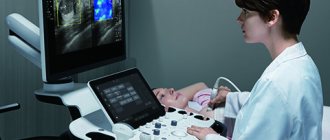Diphtheria
Whooping cough
Colpitis
Thrush
Fungus
34426 03 November
IMPORTANT!
The information in this section cannot be used for self-diagnosis and self-treatment.
In case of pain or other exacerbation of the disease, diagnostic tests should be prescribed only by the attending physician. To make a diagnosis and properly prescribe treatment, you should contact your doctor. We remind you that independent interpretation of the results is unacceptable; the information below is for reference only.
: indications for use, rules for preparing for the test, interpretation of the results and normal indicators.
Why do you need a flora smear?
A gynecological smear is what the doctor should first recommend at the initial appointment, regardless of the symptoms. This study, along with colposcopy, is included in the gold standard for annual preventive examinations in women. Smear microscopy allows you to assess the condition of the vagina and the presence/absence of an inflammatory process in the organs of the reproductive system. The laboratory technician will see the number of leukocytes, epithelial cells and the ratio of bacteria on the slide. If cocci predominate over beneficial bacilli in the results or fungi are visualized, this means dysbiosis, inflammation or candidiasis. If the number of leukocytes in the smear is increased, the gynecologist may prescribe additional tests for STIs.
Symptoms of increase
Signs indicating an increase in the level of leukocytes and the development of an inflammatory process in the urinary system:
- painful urination;
- the appearance of a false urge to urinate;
- discharge of an unusual nature;
- pungent odor of genital discharge;
- burning and itching sensation inside the genitals;
- failure of the menstrual cycle;
- problems with conception;
- discomfort during sexual intercourse.
The manifestation of such symptoms is a reason to take a smear on the flora and check the condition.
The inflammatory process can occur without pronounced symptoms. It is important to listen to the slightest deviations.
Find out what the norm of ESR in the blood of women should be! Study the table of indicators for ladies of different ages.
You will learn about the causes of high bilirubin in the blood in women, and what diseases can be discussed with elevated levels in this text.
What to do if a woman's platelet count is below normal? We will tell you about the functions of these cells and the features of treating abnormalities here.
Preparing for a smear test
The optimal time for a smear on the flora is the middle of the cycle. During menstruation, biomaterial is not collected. This is due to the fact that the presence of blood cells can significantly distort its results.
Material for analysis can be taken from the urethra, from the vaginal walls or from the cervical canal. The preparatory measures for all three studies do not have any fundamental differences. At the consultation, the obstetrician-gynecologist will clarify whether antibiotics have been taken in the last two weeks before the appointment. If the answer is positive, the smear will be rescheduled for another time. The most reliable results can be obtained only by observing a number of conditions.
On the eve of the smear you should:
- for two to three days, eliminate the use of any vaginal suppositories;
- limit sexual intercourse in two to three days;
- the day before the test, do not take a bath (shower only);
- Avoid vaginal douching in two days;
- on the day of visiting the doctor, perform a standard toilet of the genitals with water;
- reschedule other gynecological examinations to another time (for example, colposcopy, ultrasound scanning with an intravaginal probe).
When to take a cervical smear: indications
It is important that a woman does not forget to visit a gynecologist annually and have cervical smears. Indications for the study are:
- vaginal discharge;
- pulling pain in the lower abdomen;
- disruptions of the menstrual cycle;
- absence of such studies in the anamnesis;
- heredity burdened with cancer;
- presence of HPV (human papillomavirus);
- taking combined oral contraceptives;
- first trimester of pregnancy;
- rash, redness of the external genitalia.
Smear standards for flora
Normally, among the microorganisms that make up the vaginal biocenosis there are lactobacilli, gram-positive bacilli, bifidobacteria, opportunistic microorganisms and fungi. In a healthy woman, about 90% of the microflora is made up of beneficial bacteria. These microorganisms prevent the proliferation of conditional pathogens and fungi, releasing special substances that have an antibacterial effect. When the number of beneficial bacteria decreases, conditional pathogens begin to grow. This condition is called flora dysbiosis and requires therapy. Treatment consists of strengthening the immune system with probiotics. In some cases, your doctor may prescribe antibiotics.
Among other microorganisms, the smear may contain staphylococci, streptococci and other bacteroids. Their number should not exceed 5% of the total bacterial mass.
The norm of leukocytes in a vaginal smear is from 0 to 15 units. In the urethra and cervix - up to 10 units. Leukocytosis is considered a condition in which their number in the analysis exceeds 15 or more units. As a rule, during pregnancy and during the recovery period after childbirth, this figure increases slightly. Such leukocytosis does not have any accompanying symptoms and does not cause discomfort in the woman.
The smear results contain small numbers of squamous epithelial cells. Their level in women correlates depending on the day of the menstrual cycle. If there are many such cells in the analysis, and they are visualized in layers, this may be the result of an inflammatory process in the vagina.
Another indicator of the study is the mucus secreted by the glands of the cervical canal. If such mucus is found in excess, this may be a sign of acute or chronic cervicitis.
High content after childbirth
Leukocytes instantly react to the slightest deviations or changes in the functioning of the body. Therefore, their levels often increase for physiological reasons. This also includes the postpartum period.
During childbirth, a woman loses a lot of blood.
To prevent complications, immune white cells are prepared in advance for such a situation and accumulate in large numbers in the uterine area.
This is associated with an increase in the number of their indicators in a smear after childbirth.
Their number increases during the onset of labor and during the recovery period. The indicators return to normal 4-5 days after birth.
If the elevated level of immune cells lasts more than 5 days and has serious deviations from the norm, this indicates the development of complications after childbirth and inflammation in the uterine cavity, kidneys or urinary system.
In such cases, you should immediately consult a doctor.
How long to wait for research results
In general, the time frame for a smear test for women is from one to four days. In this case, the day of the visit to the obstetrician-gynecologist is not taken into account. The duration of obtaining analysis results is determined by the specifics of the laboratory research method. The condition of the vagina, cervix and urethra is assessed within 24 hours. If the test results are unsatisfactory, the doctor may prescribe a PCR test*.
Advantages of the PCR method:
- reliability due to high sensitivity;
- speed of execution;
- specificity for STIs in any form;
- the ability to diagnose most infections of the urogenital tract;
- accuracy of determining the type of infectious agent.
Integration of various laboratory methods
In the diagnosis of cervical diseases, clinical data and microflora test results (classical microbiological (culture), ANC methods (PCR, RT-PCR, Hybrid Capture, NASBA, etc.) are important).
If it is necessary to clarify the pathological process (ASC-US, ASC-H), cytological examination is, if possible, supplemented with molecular biological ones (p16, oncogenes, methylated DNA, etc.).
HPV detection tests have low prognostic significance, especially in young women (under 30 years of age), due to the fact that in most patients in this age group, HPV infection is transient. However, despite the low specificity of the test for intraepithelial tumors and cancer, it can be used as a screening test in women under 30 years of age, followed by cytological examination. Sensitivity and specificity increase significantly with the combined use of the cytological method and research to detect HPV, especially in patients with questionable cytological data. This test is important in the management of patients with ASC-US, during follow-up to determine the risk of relapse or progression of the disease (CIN II, CIN III, carcinoma in situ, invasive cancer).
Why do leukocytes increase in pregnant women?
OAM is a mandatory test prescribed for pregnant women. In the third trimester, indicators must be monitored weekly.
Due to the fact that the antigenic load on the body increases, a slight excess of the leukocyte norm is allowed in the tests.
A sharp increase in concentration gives the doctor reason to suspect:
- diabetes mellitus in pregnancy;
- diseases of the urinary system (cystitis or pyelonephritis);
- complication in the form of severe kidney damage;
- thrush;
- disturbance of bladder tone.
Complexes with this research
Women's check-up No. 2 Preventive examination of the urogenital tract 5,140 ₽ Composition
Examination during pregnancy. 3rd trimester 6,310 ₽ Composition
Women's safety Preventive examination of the pelvic organs 1,640 ₽ Composition
IN OTHER COMPLEXES
- Examination during pregnancy. 1st trimester 11,430 RUR
- Joining IVF RUB 16,590
- Women's reproductive health RUB 2,780
- Pregnancy planning. Cervical screening and STIs RUB 3,450
Features of the neutropenia process
Neutropenia is a condition when neutrophilic white blood cells are low in the blood. It has already been said above that neutrophils react to foreign bodies in the body and in every possible way protect and keep the immune system in order. That is, when neutrophils detect an infection in the body, they form a “block” around the inflammation, thereby creating obstacles to the further spread of foreign agents. The result of such a struggle between neutrophilic leukocytes and infection will be the formation of pus in the wound, inflammatory and intoxication syndrome.
The disease can be hidden if the person initially has neutropenia, but because of this, the infection can spread throughout the body and lead to sepsis. The first clinical manifestations of neutropenia may be:
- stomatitis;
- gingivitis;
- purulent sore throat;
- osteomyelitis;
- abscess;
- sepsis.
Those patients who are susceptible to neutropenia should avoid contact with other sick people, and they are also not recommended to be in a place where there are large crowds of people. Every year it is necessary to carry out planned prevention of seasonal diseases. In addition, microbes that are completely safe for the average person can adversely affect the health of patients with neutropenia.
Drug treatment
As noted, an increase in white immune cells can occur due to an inflammatory or infectious disease. Treatment for inflammation or infection is varied.
Treatment of the inflammatory process is carried out according to the following scheme:
- Use of antiseptics. The vagina is regularly washed with antiseptics “Miramistin”, “Chlorhexidine”, “Potassium permanganate”.
- Antibacterial drugs are used. "Genferon", "Pimafucin", "Terzhinan", "Viferon" are prescribed.
- For the treatment of candidiasis - Fluconazole and Flucostat.
Treatment of the infectious process is carried out according to the following scheme:
- Intravenous use of antibacterial agents: Ornidazole, Metronidazole and Tsiprinol.
- Prescription of drugs for the prevention of vaginal dysbiosis: “Bifidumbacterin”, “Laktovit” and “Lactofiltrum”.
Note: it is forbidden to self-medicate using antibacterial agents. They are prescribed only by a competent doctor, taking into account the severity of the disease and the patient’s condition.
Kinds
Neutrophil granulocytes in the blood are divided into two types according to the shape of the nucleus:
- Band neutrophil leukocytes - have the shape of a horseshoe-shaped nucleus, are considered immature or young neutrophils.
- Segmented neutrophil granulocytes are a mature form of neutrophil with a segmented nucleus. They are also called “heroic” because when they encounter microbes they absorb them and die.
In order to determine the condition of the human body, experts compare the percentage of mature and young neutrophils. It is known that in newborn children there is an increased number of band neutrophils, but later such cells are replaced by segmented representatives. And after three weeks of the child’s life, the balance between mature and young cells is equalized.
Neutrophils. What is this?
Neutrophil leukocytes, or as they are also called neutrophil granulocytes, are a type of white blood cell. They look like white blood cells, their important function is to protect the body from the effects of bacterial infections, as well as support the human immune system itself.
The place of neutrophil maturation is the bone marrow, then they “migrate” into the blood, and their speed is 7 million per minute. Neutrophils circulate in the blood for 8 hours to 2 days, after which they move into tissues, where they perform their main function - protecting the body. In these same tissues, neutrophils die.
Neutrophils are the most significant and quite numerous of all subtypes of leukocytes in the blood, and their percentage is 45-70% of leukocytes, the diameter of which is 12-15 microns.
Neutrophilic leukocytes perform the “ambulance” function. They pick up “inflammatory signals” and immediately move to the site of the lesion. Inflammatory reactions can occur as a result of burns, wounds, ulcers, injuries, etc. A decrease in the level of neutrophils occurs as a result of the presence of a virus and parasitic infestations in the body.










